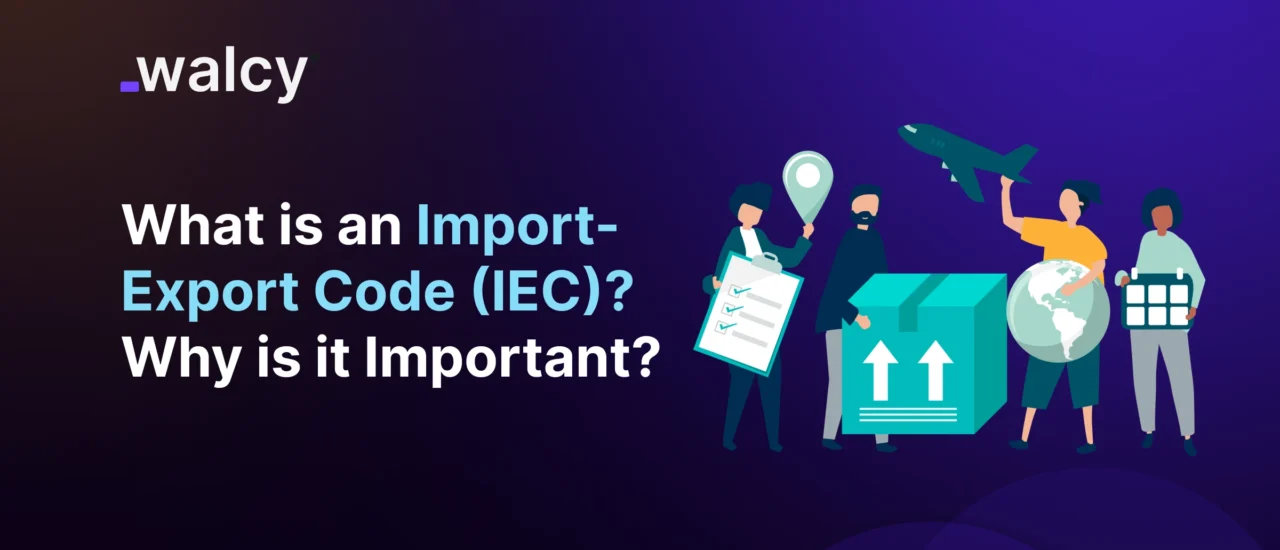India’s economy is seeing significant growth in the import-export sector, which has enhanced its standing as a leading global economy. India is a highly sought-after market for other nations since it has one of the largest trade-based economies globally. It can be said that India’s commercial situation is, at its finest point ever. Consequently, trade between India and other nations continues to increase at a remarkable rate.
The Import-Export Code (IEC) is a vital component of a trading business in India. In this blog, we will define an IEC, discuss its significance, cover how to obtain one and look at some fascinating data on commerce in India.
What is an Import-Export Code (IEC)?
The Import-Export Code (IEC) is an exclusive 10-digit code made up of alphabets and numbers which is used as a business identification code. It is provided by the Directorate General of Foreign Trade (DGFT), an organ of the Indian government’s Ministry of Commerce and Industry. It is a compulsion for any Indian business or individual to have an IEC to engage in international trade. Without it, no one in India can legally partake in international trade, unless specifically exempted by the DGFT.
The IEC Certificate, contains the IEC code, the firm’s PAN, date of issuance, registered address, name of the signatory, partner numbers, and other relevant information for identifying the IEC certificate.
Interestingly, the IEC code is not necessary for service exporters like software technology companies unless they are directly taking benefits under the Foreign Trade Policy. This code is only necessary for those entities that trade in commodities, not for service-centered companies.
How to Get an IEC?
Since the IEC is issued by the DGFT, they have an electronic form called the e-IEC, and the DGFT has a web portal through which you can file an IEC. The application cost for an IEC filing is INR 500 only. However, there are some technical requirements to be noted for filing an IEC, which are as follows:
- Digital Signature Token (Class II or III): Required to authenticate and secure the application.
- PAN Card: Business identification for tax purposes.
- An active and verified mobile number along with a valid email address: For communication and verification purposes.
- Business Address Proof: A registered business address must be provided.
- Bank Account Details: A bank account in the name of the applicant or business.
- Aadhaar Card: For identity verification.
Now that all the necessary documents have been listed, you can start the process of filing the form. Thankfully, the application is easy to fill out online. First, you need to head to the Directorate General of Foreign Trade website (https://dgft.gov.in) and complete the online form for the IEC.
You’ll just need to submit all the aforementioned things like your PAN card, a passport photo, proof of your business address, and some bank-related information. Note that the bank account should be named under the organization’s name. After completing all the processes and attaining your Import-Export Code, it is automatically valid for life. However, one must remember to keep the details of the trading entity updated with the government if anything changes in the future. A typical timeline to receive IEC is 7-10 business days.
Read about: GST For Foreign Exchange Transaction? Must Know Things.
Why Import-Export Code is Important?
First and foremost, it is legal compliance with Indian law that renders businesses to mandatorily import and export goods. Without it, the customs do not allow goods to pass through Indian territory. Furthermore, it is also required for banking institutions to process payments related to international trade, and therefore, for smoother banking transactions, IEC is mandatory.
Moreover, for businesses eyeing global outreach, import-export code allows them to tread the international markets expand their reach, and transcend international boundaries. It also allows for B2B opportunities like improving connections with foreign businesses, which fosters B2B trade relationships in other nations.
Another importance of the import-export code is the statutory recognition that you get with it since it acts as a valid proof of authorization for international trade, and it is also important for customs clearance.
Finally, for government subsidies and benefits, the Indian government offers various subsidies and incentives to certain commodities to encourage trade in those commodities, and the IEC allows participation in trade fairs, availing of duty drawbacks, and export promotion councils.
Read about: All About Overseas Payments (2024): Comprehensive Guide
The Trade Landscape in India in 2023-24
With overall imports of $678,214.77 million, entire exports of $437,072.03 million, and the overall deficit of $241,142.74 million for the years 2023–2024, India continues to be in trade deficit. According to the statistics, India’s total imports dropped by 5.27% between 2022 and 2024, from $715,968.90 million to $678,214.77 million.
This decline was attributed to substantial growth in businesses such as art, tanning or dyeing extracts, sugars, and sugar confectionery. Other notable declines included the 41.86% decline in fertilizer imports and the staggering 16.05% decline in mineral fuels, oil-based products, and products, which reflected lower energy imports.
Mineral fuels, oils, and items with HS Code 27 accounted for some of the most significant trade imbalances, with the following numbers showing the greatest deficit: $219,053.64 million in imports (32.30% share) and ₹87,602.37 million in exports (20.04% share) indicate a significant reliance on energy imports. Second, the accompanying statistic for Electrical Machinery and Equipment (HS Code 85) demonstrates a significant trade imbalance and a strong reliance on imported machinery and technology.
$79,300.65 million in imports, $34,412.48 million in exports, and $44,888.17 million in deficit are the totals. Thirdly, there was a $45,620.46 million shortfall indicated by the HS Code 71 for Natural or cultivated Pearls, Precious or Semi-Precious Stones, and Valuable Metals.
The import and export figures for 2023–2024 show that trade conditions for India are mixed. While some lucrative industries, like pharmaceuticals, have a substantial export surplus, other industries, including natural fuels and electrical gear, rely heavily on imports.
Therefore, it is justifiable to conclude that increasing nationwide manufacturing capabilities in electronic machinery and less dependence on mineral fuels present the potential for lowering trade imbalances. India has the option to work with private firms to explore its deposits of oil and gas or invest in domestic generation of renewable energy. Moreover, India may establish Special Economic Zones (SEZs) dedicated to the manufacture of electronics, provide tax advantages and subsidies to encourage local production, and establish a domestic supply chain for semiconductors and other components.
Lastly, by using imported metals and stones, India could prioritize supporting the development of jewelry, other value-added items, and domestic production. In doing so, the deficit is decreased by raising the export value. The government can bargain to get advantageous trade agreements with nations that manufacture metals and stones on a global scale, which might cut the price of imports.
Broader Strategies to Address Trade Deficits
It is essential for the promotion of export-oriented industries by encouraging diversification in export portfolios via identifying and nurturing emerging sectors like technology, pharmaceuticals, and organic products. Another interesting approach could be encouraging the growth of substitution industries that can produce goods domestically and via tariffs, subsidies, and support for SMEs. This should adequately motivate entrepreneurs to leverage such opportunities and help improve India’s domestic manufacturing landscape.
You shall love: Solutions to Most Common Financial Challenges For Business.
Conclusion
Import-Export Code is mandatory for international trade, and it is a legal requirement for businesses to submit an IEC to enable international trade and smooth cross-border transactions. The IEC has a streamlined online application process, and once issued, it does not have any expiration date. Furthermore, since it is an online application process, one will not experience bureaucratic hindrances, which encourages enterprises to explore global trade opportunities.
In terms of diversification, India should promote diversification in export portfolios and focus more on emerging industries like electronics, pharmaceuticals, and locally manufactured products. Incentivizing SMEs to encourage them to participate in export activities, while offering necessary support through subsidies, tax breaks, and infrastructure development, is crucial.
Finally, by fostering innovation, promoting sustainable industries, and engaging in inter-government discussions for favorable trade agreements, India can ensure long-term stability and growth in its trade.



